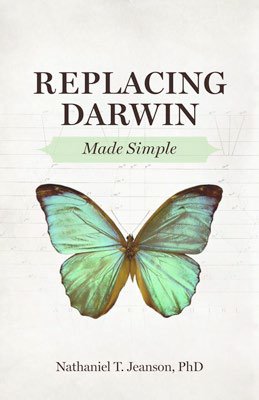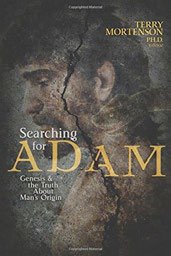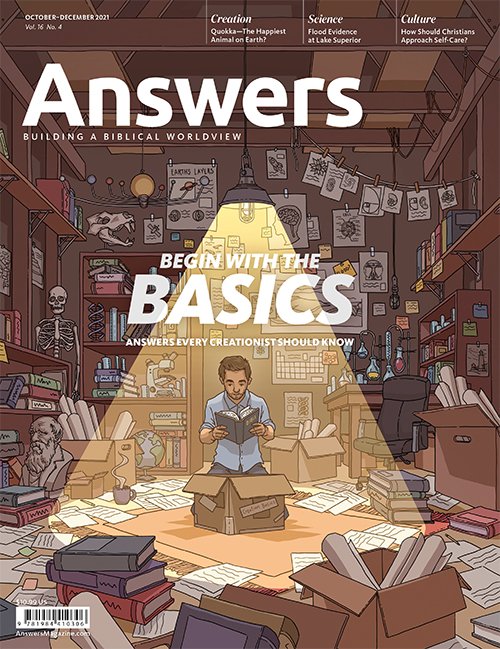So You Want to Know the Basics?
Curious about creation but don’t know where to start? Let’s begin with the basics.
Do any of these statements sound familiar?
Earth is millions of years old. Adam wasn’t a real person. Humans evolved from apelike ancestors. Genesis doesn’t matter—just the New Testament. If you believe in creation, then you don’t believe in science.
Messages like these pervade the materials we read, the shows we watch, and the news we listen to. Even many Christian leaders mix millions of years of evolution into the Genesis creation account. At every turn, we’re bombarded with ideas, opinions, memes, mixed messages, and misinformation advocating an evolutionary worldview.
Trying to detangle facts from fiction in these messages can feel frustrating—if not downright intimidating. As humans who will never be able to understand everything, how can we know what to believe? Who do we trust as our authority for truth? And where can we find a reliable starting point to understand these difficult topics?
Here’s some good news: there is a starting point that we can trust from beginning to end—God’s Word. Daunting questions become far simpler to answer when we base our thinking on a true foundation, and the firmest foundation for truth is Scripture. When we accept God’s Word as it’s written, we have a surefire starting point for reasoning about the world—including its difficult questions.
Still, even beginning with the Bible leaves a lot of information to unpack. You can dig deeper through other Answers in Genesis resources, but to give you a solid start, here are some of the most basic questions gathered into one place. Discovering answers to these foundational questions strengthens our faith, expands our knowledge of God’s Word, equips us to disciple fellow believers, and helps us share our hope in Christ.
Does it matter if the days of creation were 24-hour days?
Some Christians believe that millions to billions of years elapsed within the six creation days of Genesis 1. But if we’re honest, this belief does not come from a straightforward reading of God’s Word. It comes by inserting human ideas (like the story of evolutionary origins) from outside the Bible into Scripture. God can reveal truths through his Word because he hardwired humans to understand language. From day six of creation, language allowed Adam to receive God’s instructions, name animals, and communicate with Eve. Words carry specific meanings in specific contexts, making communication possible. Accordingly, Genesis is written in plain language for ordinary people to understand and teach their children.
For example, Genesis 1:5 plainly reveals that after God created light, “God called the light Day, and the darkness he called Night. And there was evening and there was morning, the first day.” The accounts of days two through six follow a similar pattern, associating each day with an evening, morning, and number. When God finished creating, he rested on another day bearing its own number: seven.
How do we know these days were literal 24-hour periods—and why does it matter? Like the English word day, the Hebrew word for day, yom (יוֹםֹ) can mean a 24-hour period, an interval of daylight (as opposed to night), a specific time, an era, or a year. And as in English, the word’s meaning is clear from its context. Every other instance when the Old Testament mentions yom with an evening, morning, or number, yom means an ordinary day.
Had God meant to communicate that he created over long ages, he certainly could have. But he didn’t. We have no reason to second guess God’s plain revelation. Jesus and New Testament writers viewed Genesis as history. Careful evaluation of the text affirms Genesis was written as history.
If Genesis 1 is the only passage in which we think day means something entirely different from its context indicates, that’s a sure sign something is wrong with our interpretation of God’s Word—not with the passage itself. We have every reason to make God’s infallible Word the starting point for our thinking. When we do, the meaning of yom becomes clear as day.
What sets humans apart from other animals?
Read More
Rethink Darwin’s claims as you read Dr. Nathaniel Jeanson’s compelling alternate explanation for the origin of species.
According to the evolutionary origins story, humans are animals in every sense—living accidents with no purpose but surviving to perpetuate our meaninglessness. Human morals are an animal invention. Human love is an animal instinct. Human rights are a type of animal rights (and vice versa). Abortion, eugenics, slavery, and genocide flow logically from this worldview.
God’s Word, however, reveals a far different picture of human origins—and therefore, human meaning. According to Genesis 1:27, “God created man in his own image, in the image of God he created him; male and female he created them.”
That word image, which Genesis 1:26 clarifies to mean “in the likeness of,” refers to capacities that God gave humans as reflections of himself. As God’s image-bearers, we have personal spirits able to make free decisions; to appreciate immaterial concepts like truth, beauty, and logic; and to be in relationship with God and one another. We can reason, discover, philosophize, create, communicate, and love. Sin has corrupted God’s image in us, but no hazard of our sin-broken world—including disability, deformity, or death—can negate it.
Being specially created in God’s image sets us apart from animals. While God’s image is spiritual, we see it reflected in certain physical traits unique to humans. Unlike apes, for instance, humans possess both “hardware” (specialized vocal organs) and “software” (neural programming) for language. And while chimps can mimic some human behaviors, our brains are far more complex than chimp brains, providing a scaffold for reasoning and relating as only an image-bearer can do.
Other physical, mental, and genetic differences between humans and apes further affirm that we’re unique creations rather than evolutionary offshoots. But it is our spiritual natures that truly distinguish us as image-bearers with immortal, relational, redeemable souls.
Unlike evolution, this biblical view supplies a foundation for human rights. Because every human is made in God’s image, every human life has meaning, value, and dignity. Fashioned in God’s image, humans are priceless in every sense.
If evolution isn’t true, what’s the history behind the diversity of living things?
With God’s Word as our starting point, we have a firm foundation for understanding the world—including its kaleidoscope of living things. Where did biological diversity come from?
The answer first appears in Genesis 1, which refers (10 times!) to God creating living things “according to their kinds.” The word kind resurfaces in Genesis 6, recording how two of every kind of land animal (14 of some) entered Noah’s ark. Consequently, these animals could fulfill God’s plan for them to repopulate earth after the flood (Genesis 8:17).
The connection between kind and reproduction suggests that kinds represent the broadest groupings of organisms that can reproduce among themselves. Dogs, cats, and horses, for instance, have reproduced among themselves to yield an immense variety of dog, cat, and horse breeds. But dogs cannot cross with cats or horses because they’re different kinds. Instead, dogs will always produce—drumroll, please—dogs.
Scientists who study created “kinds” (baraminologists, from the Hebrew words bara [ברא], “create,” and min [מין], “kind”) often find that kind corresponds to the family level of modern taxonomy. However, because biblical and manmade classification systems need not align perfectly, kind may refer to other levels too.
So where did all the varieties within kinds come from—like wolves, jackals, and chihuahuas within the dog kind? Biblically, we infer that God created living things with genetic diversity that can be combined in different ways to reveal incredible variation within kinds. For example, the dogs that exited the ark would have had the genetic potential to produce all the varieties of dogs we see today.
As dogs spread around the world, processes like natural selection acted on dogs’ genetic diversity by favoring genes best suited to specific environments, resulting in traits like genes for long fur in cold climates or short fur in hot climates. Natural selection sorts pre-existing DNA but does not create new genetic information, neither do mutations—mistakes in DNA. For instance, mutations can alter preexisting genes to produce curly-haired dogs, but they do not create novel genes for feathers instead of fur.
But the evolution of all living things from common ancestors would at some point require the creation of new genes. Natural selection and mutation result in the loss or alteration of existing genetic information, not the gain of new information needed to change one kind of creature into another. Though often considered a driving force of evolution, natural selection is not synonymous with evolution. We observe natural selection happening today, but we do not and cannot observe “molecules-to-man” evolution.
Genetic data does not support evolutionary origins but is consistent with biblical models. Ultimately, the diversity of living things provides a real-world example of why the Bible should be the foundation for our thinking.
The Same . . . But Different
The many cat species and breeds, such as lions, tigers, jaguars, panthers, and even your housecat, originated with one original cat kind that God created during creation week.

How do we know that Adam was a real person?
There’s a sport trending among evangelical scholars: wrestling a literal Adam out of Scripture to make room for evolution. Contestants will call Adam a symbol, a myth, or a representative from an early tribe—anything besides the first man whose disobedience brought sin and death into creation. The goal is to appear scientific. But ironically, observations from genetics confirm the Bible’s teachings remarkably well.
Read More
Sixteen experts offer biblical arguments in defense of a literal Adam and the fall.
What does the Bible teach about human origins? Genesis explains that on day six of creation week, God formed Adam out of “dust from the ground and breathed into his nostrils the breath of life” (Genesis 2:7). Knowing that “it is not good that the man should be alone” (Genesis 2:18), God also fashioned Eve from Adam’s side. This account leaves no room for evolution. For instance, we can’t presume that “dust” means “apelike ancestors” because a consequence of Adam’s sin was his return into dust (Genesis 3:19). We also can’t call Adam a tribal representative because Genesis 2:5–18 reveals that, until God created Eve, no humans existed besides Adam.
Other passages throughout Scripture clearly portray Adam and Eve as the first humans. Genealogies in 1 Chronicles and the Gospel of Luke name Adam the ancestor of other historical figures including Abraham, David, and Jesus. Jesus himself indirectly referenced Adam and Eve when explaining God’s design for marriage “from the beginning” (Matthew 19:4–6).
Paul confirmed that all humans descended from one man (Acts 17:26), through whom death spread to all humans (Romans 5:12). In 1 Corinthians 15, Paul emphasized that a real Adam committed real sin, leading to real death for humanity, which explains why Jesus came as Adam’s descendant to die a real death, providing salvation for “whoever believes” (John 3:16). The gospel’s significance traces back to a literal Adam.
This does not mean that people must believe in a real Adam to be saved. Only faith in Jesus, whom Paul called “the Last Adam” (1 Corinthians 15:45), brings salvation. But if we reject the first Adam, we’ve compromised our logical basis for accepting the Last Adam. Accordingly, some writers have reinterpreted the gospel to accommodate evolution, saying that—contrary to the Bible’s core salvation message—Jesus’ death had nothing to do with paying for sin. Wrestling against Adam means wrestling against the gospel, so let’s hold fast to God’s Word, making no room for compromise.
If everybody descended from Adam and Eve, why are there so many people groups around the world?
An unspeakably beautiful day will come, according to Revelation 7:9, when believers from every nation, tribe, and language will worship together at the Creator’s throne. Individuals of all shapes, sizes, skin tones, hair types, and eye colors will praise their Savior as one. What’s the history behind the human physical diversity we’ll see in heaven—and currently observe on earth?
God’s Word clearly teaches that all humans descended from one couple: Adam and Eve (Genesis 3:20; 1 Corinthians 15:45). After the fall, their descendants grew extraordinarily evil, except for Noah and his family, whom God spared from the flood. When Noah’s descendants rejected God’s plan for humans to spread throughout earth, God separated them into different groups by language at the tower of Babel (Genesis 11).
This history helps us understand where variation among different people groups originated. Because everyone alive today descended from Noah’s family—and ultimately from Adam and Eve—these biblical ancestors must have had the genetic potential for all the variation we see in humans today. They had genetic variants that, when combined in different ways among their descendants, could produce offspring with diverse traits.
For instance, suppose Adam and Eve had middle-brown skin, resulting from the gene variants for both lighter skin and darker skin. Different combinations of these variants would easily have produced all the skin tones we see today. When humans dispersed after Babel, the human gene pool divided as well. Different traits became dominant in different groups, giving us the diversity of people groups around the world.
Cultures use these differences to categorize people into races. While such categorization occurred before Darwin, his ideas spawned new levels of horrendous discrimination against races deemed “less evolved.” However, the concept of races is neither biblical nor scientific.
Genetic studies confirm that the differences between any two humans far surpass the tiny degree of variation between so-called races. And the idea of races does not stem from Scripture, which teaches that all humans share “one blood” (Acts 17:26). We all descended from one man, have equal value as God’s image bearers, and equally need Jesus as Savior.
Babel Explains Our Differences
After the global flood, the descendants of Noah’s three sons all gathered in one place, later called Babel. God confused their language so they would disperse. The many people groups around the world today originated at Babel.

If a loving God exists, why is the world full of death and suffering?
From our earliest introductions to suffering, pain, and the reality of death, we keenly feel the world’s brokenness. Why is our world full of sorrow, especially if a loving God created it? This vexing question has no answer apart from God’s Word.
Scripture reveals that God did not create a world of death and suffering. Instead, in the beginning, God called everything “very good” (Genesis 1:31). God can call something good because his character is the source of both absolute goodness and absolute truth. But if everything evolved without God, then we have no consistent foundation for defining good or evil—or for considering death and suffering a problem. After all, an evolutionary worldview says death is a necessary part of life, with the “fittest” being especially apt to survive.
But according to Genesis, animals haven’t always needed to kill or outcompete each other for survival. In fact, God originally ordained humans and land animals to be vegetarian (Genesis 1:29–30). Carnivory, suffering, and death had no place in this perfect creation. What changed? Genesis 2:16–17 recounts that God had forewarned Adam, “You may surely eat of every tree of the garden, but of the tree of the knowledge of good and evil you shall not eat, for in the day that you eat of it you shall surely die.”
Death is the inevitable result of severing ourselves from God, the giver and sustainer of life. Romans 5:12 explains that death spread to all humans through Adam’s sin. This sin affected all physical creation (Romans 8:22) over which God gave humans dominion (Genesis 1:26). We now see sin’s effects, including thorns, death, and disease throughout the world—and even in the fossil record.
For instance, dinosaur fossils show evidence of combat, carnivory, and even cancer. And fossils themselves represent dead things. These fossils could not have been deposited millions of years before Adam’s sin. Otherwise, death and suffering would have belonged in the world God deemed “very good.” This would undermine God’s character—especially if he used death-driven evolution to create. Like atheistic worldviews, theistic evolution (the belief that God used evolution) cannot answer the question of suffering.
A biblical worldview, however, recognizes that death and suffering are real problems. We’re to blame, not God. Yet Jesus lovingly took sin’s effects on himself, paying its penalty on behalf of sinners. We still encounter trouble in our sin-broken world (John 16:33). But we have hope because Jesus promises to be with us until the end, when he’ll make creation whole again.
What does creation have to do with the gospel?
Read More
The Lie: Evolution/ Millions of Years
Consider the far-reaching effects of compromising Genesis with evolutionary ideas in this popular book by Ken Ham.
The ultimate point of answering questions like, “Did Adam really exist?” or “How did life’s diversity originate?” isn’t to win arguments. It’s to strengthen our faith and to remove intellectual barriers to the gospel. The gospel refers to the good news of Jesus’ death and resurrection (1 Corinthians 15:1–4). We can better understand—and therefore, proclaim—the significance of these events when we see them as part of the bigger picture of history from Genesis to Revelation.
This gospel history begins with a holy, triune Creator fashioning a perfect world. Adam’s rebellion destroyed that perfection, separating all humans from their life-giver, God. As a result, every descendant of Adam is destined to physical and spiritual death.
That’s the bad news. The good news is that God loved the world so completely, even in its sin-broken state, that he had a plan to restore creation to himself. Only a sinless descendant of Adam—one who was both fully God and fully human—could reconcile God and humanity by paying sin’s death penalty. So Jesus, the Creator himself, stepped into creation. He paid sin’s penalty on the cross, offering to exchange our sin for his righteousness if we come to him. Then he rose from the grave, triumphing over death so we could live reconciled to God through Jesus forever. All physical creation, in fact, will be reconciled to God when he creates the new heaven and earth, restored to its original perfection.
The good news of the gospel makes sense in the context of the bad news established in Genesis. That’s not to say we must believe in a literal Genesis to be saved. Remember, only Jesus accomplished our salvation. But Genesis provides the logical foundation for understanding why we need Jesus. If we can’t trust what the Bible says in Genesis, how can we believe what it says about Jesus?
The ultimate purpose of defending Genesis—including by answering tough questions rooted in its doctrines—is to proclaim the gospel in love. And the best way to defend and proclaim the gospel is by starting from the foundation of God’s Word.
Answers Magazine
October–December 2021
Curious about creation but don’t know where to start? Let’s begin with the basics.
Browse IssueRecommended Resources

Answers in Genesis is an apologetics ministry, dedicated to helping Christians defend their faith and proclaim the good news of Jesus Christ.
- Customer Service 800.778.3390
- Available Monday–Friday | 9 AM–5 PM ET
- © 2026 Answers in Genesis










